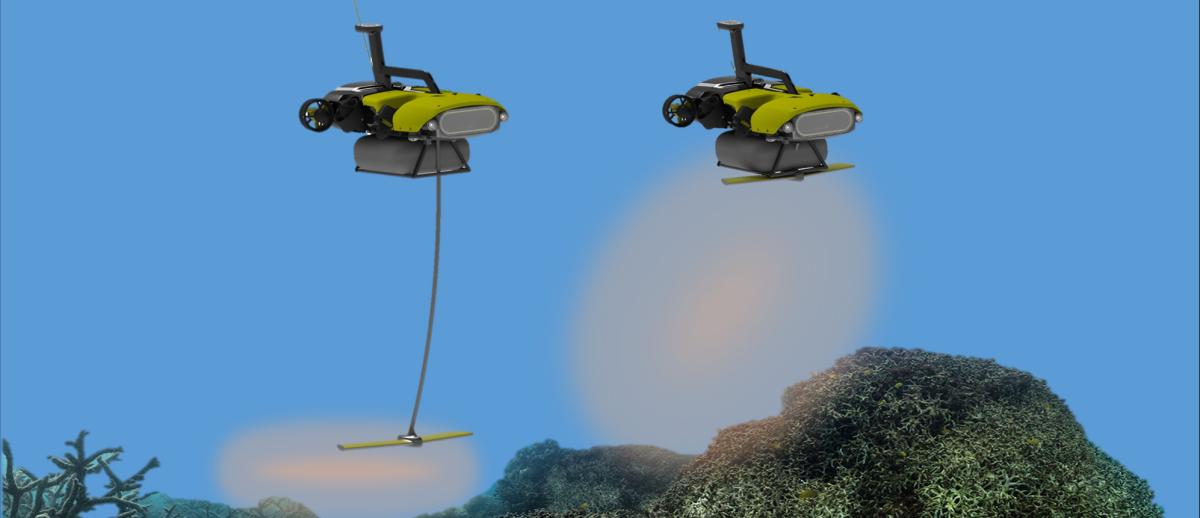Internet of Things for Environmental Protection and Economic Development: The Role of Universities and Scientific Diplomacy
archive


“LarvalBot,” designed by researchers from the Queensland University of Technology, sprays microscopic coral larvae over damaged areas of Great Barrier Reef. (Source: TechCrunch)
Internet of Things for Environmental Protection and Economic Development: The Role of Universities and Scientific Diplomacy
It is possible to relate to the concept of the fourth industrial revolution in different ways,1 but objectively, we are witnessing a synthesis of three worlds: physical, informational (or digital), and biological. And the key technology in this process is the Internet of things (IoT). A World Economic Forum (WEF) report defines IoT as the measurement and remote control of previously unrelated “things.” The technology reaches people and objects that it wasn’t able to reach before2 and is increasingly seen not only as a way of digital transformation of the economy, but also as a technology for achieving the goals of the UN Sustainable Development Program—a fact also recognized by many experts.
Universities contribute centrally to the development of IoT and IIoT (Industrial Internet of Things) including, significantly, their application for environmental protection and monitoring. Considering that they are also among the leading sources of expertise for scientific diplomacy, institutions of higher learning have an implicit role to play in achieving the sustainable development goals set by the UN for 2030, and in effectively addressing other pressing global challenges.
IoT, SDGs, and the Environment
In 2017 the international forum Internet of Things Week in Geneva adopted the “Internet of Things Declaration to Achieve the Sustainable Development Goals.”3 In 2018, experts from the WEF analyzed 640 projects that use IoT. They concluded that 84% of these projects contribute to the achievement of the UN Sustainable Development Goals, and also noted the economic benefits of the introduction of IoT technology. According to their estimates, only the tech of the “Industrial Internet of Things” (IIoT) can contribute an additional $14 trillion USD to the world economy by 2030.4
Nevertheless, the question may be asked: Are there solutions and projects implemented using IoT and IIoT that can also help to preserve the environment? Actually, quite a few projects can be named.
At the Geneva Internet of Things Week forum, a professor from the University of Melbourne described the use of IoT on five different sections of the Great Barrier Reef. Sensors are used to monitor water temperature and carbon dioxide content in water in order to track the health of corals. An experimental underwater robot, “LarvalBot,” designed by researchers from the Queensland University of Technology is being tested on one of the sections of the Great Barrier Reef.5 The robot sprays microscopic coral larvae over damaged areas of the reef, thereby contributing to the preservation corals and the Great Barrier Reef as a whole. Also of note is the project "Ocean of Things," sponsored by a division of Xerox. This project consists of a network of robot buoys, each carrying about twenty environmental sensors recharged from solar energy. The network is deployed for ocean health monitoring in the bays of Southern California and the Gulf of Mexico.
Other Initiatives
Russia plans to implement at least 15 remote control (remotely supervised) IoT solutions as part of the creation of a "Unified state platform for data collection of the industrial Internet of things" by 2022. The platform is being created at the initiative of the Ministry of Digital Development, Communications and Mass Media of the Russian Federation. Leading digital commercial companies are involved in the development of the platform on a competitive basis. It is assumed that the platform will be used as a cloud solution by control and supervisory authorities for remote sensing and data analysis. This will allow for monitoring more social and environmental parameters, including environmental protection. It is assumed that the platform will significantly reduce the cost of inspections by supervisory authorities.
In this regard, the Russian I.T. company WaveAccess6 has already developed four functioning services: 1) remote monitoring system for cultural heritage sites; 2) monitoring of atmospheric air conditions; 3) remote monitoring of illegal deforestation, and 4) remote monitoring of agricultural land overgrowth. The services are implemented using IoT and machine learning technologies that employ automatic analysis of satellite images using neural networks, which makes it possible to detect illegal logging and misuse of agricultural land in a timely manner.

Lesnoy Dozor (‘Forest Watch’) system KEDR, developed with support of the Russian branch of the World Wildlife Fund. (Source: XXX)
In the field of forest monitoring, at present two other systems using IoT technology are already operating in Russia and one more is planned for implementation. These include the system Lesnoy Dozor (‘Forest Watch’),7 the monitoring system KEDR (developed with support of the Russian branch of the World Wildlife Fund8), and ‘Digital Forestry’.9 The Lesnoy Dozor solution consists of a network of Internet-connected rotating thermal imagers and IP video cameras installed on towers that determine the coordinates of smoke and fires within a radius of 30 kilometers. Data is instantly reported to the operator and the local fire department. The system works to detect forest fires at an early stage and is already used in more than 30 regions of Russia. The company has also entered the European Union market with three projects that have been implemented in Bulgaria. KEDR is a system for operational monitoring of forest changes that analyzes satellite images and receives signals from users’ mobile applications.
Thus, anyone who downloads the app on a smartphone or iPad can inform the control center about the forest violations they have seen. Finally, the ‘Digital Forestry’ project began development in 2020. It is planned that with the help of drones, satellite images, and marking trees and forest machinery, it is possible to solve the problem of illegal logging. In particular, the system will monitor whether a forester has authorization to stay and work in a specific part of the forest.
...the “Industrial Internet of Things” (IIoT) can contribute an additional $14 trillion USD to the world economy by 2030.
As an example from yet a different region, in the Middle East some countries are using IoT and IIoT to save water resources. One such solution is based on the “Qatar National Vision 2030 program,” in which Qatar has built wastewater recovery facilities for use in air conditioning systems and for irrigation. The NEXUS Integra platform is used for managing infrastructures10 and also employs IoT and IIoT technologies.11
The Role of Science Diplomacy
As this brief list of examples makes clear, scientists from around the world are joined by private industry in efforts to protect the environment, solve the problem of global warming, and preserve the biological diversity on the planet. They contribute to the intensive and constant communication between the state, public organizations, the scientific community, and business on the implementation of advanced IoT and IIoT technologies for nature conservation. This makes university-based researchers—at least implicitly—a key group of actors in scientific diplomacy in this area. Technologies and knowledge for the rescue and conservation of nature should be available to all states, and scientists could play a much greater role as popularizers of such technologies both in their own countries and abroad. The preservation of our planet can only succeed through joint efforts, as the efforts of individual states is not enough for a global solution.
Furthermore, amidst a present marked by enhanced rivalries and diplomatic strain between many countries, scientists and researchers continue to cooperate. The international community is beginning to recognize scientific diplomacy as perhaps one of the important tools for the development of international relations and solving global problems. This became especially clear in 2020, when the COVID-19 pandemic showed that all of humanity faced a global crisis and the way out is possible only through scientific research in the field of virology and the creation and distribution of vaccines. Without exaggerating the scale of the threat, UN Secretary-General Antonio Guterres called the COVID-19 pandemic “the fifth horseman of the Apocalypse.”12 It is scientists who can save the world—this is one of the main theses of the year 2020, an understanding shared by more and more people on the planet.
...scientists could play a much greater role as popularizers of such technologies both in their own countries and abroad.
Moreover, in the present realities of sanctions policy it is also scientists that can help ameliorate international tension that exists today, especially along the fault lines between the collective West and Russia. Everyone knows perfectly well what a difficult relationship Russian-American relations are experiencing now. But few may be aware that a new cooperation agreement was signed between the Russian Academy of Sciences and the US National Academy of Sciences on July 30, 2020.13
This example once again confirms that scientists are aware of the need for international cooperation, especially in the conditions of international turbulence, the fight against pandemics, and global environmental problems. And in the last few years, centers and networks of scientific diplomacy have been established in many countries where projects aimed at expanding scientific diplomacy have been implemented. Some noteworthy examples including European Union states like Austria and Spain14 as well as UE-wide initiatives15 and in non-member neighbor, Switzerland;16 New Zealand;17 Japan;18 Russia,19 and the United States.20
Conclusion
This brief list of projects and initiatives is only intended to highlight the worldwide scope of activity among not just foreign ministries, but research centers and the business community in the development of networks, projects, and organizations that are aimed at cooperation between scientists from different countries that share a commitment to sustainable development. Therefore, we believe that today such a global network of diverse centers of scientific diplomacy and universities, research centers, and business interests not only can but already is contributing to the conservation of nature and biodiversity on our common planet Earth—and not just in in regard to developing and implementing IoT and IIoT technologies. Such networks of expertise and diplomacy will contribute to solving global problems, achieving Sustainable Development Goals, and maintaining dialogue on important international issues based on the principles of peace, mutual respect, and equality.
1. Schwab K. The Fourth Industrial Revolution. Portfolio/Penguin, 2017 – 184 p.
2. Internet of Things: Guidelines for Sustainability. Geneva: World Economic Forum, 2018, p. 20.
3. “Internet of Things Declaration to Achieve the Sustainable Development Goals.” Adopted by the participants of the Internet of Things Week 2017 on June 9, 2017. URL: https://iotforum.org/wp-content/uploads/2019/10/IoT4SDG-Declaration.pdf
4. Internet of Things: Guidelines for Sustainability. Geneva: World Economic Forum, 2018.
5. Reef RangerBot becomes ‘LarvalBot’ to spread coral babies. – URL: https://www.qut.edu.au/news?id=137688
6. WaveAccess. URL: https://www.waveaccess.ru
7. “Lesnoy Dozor” (Forest Watch) developed by the company by the company Disicon. URL: http://www.lesdozor.ru/
8. Operational monitoring system for forest changes «KEDR» - URL: https://citorus.ru/producty/reshenie-dlya-lesnoi-otrasli
9. Developed by the company Element, the Digital Forestry project will help solve the problem of illegal logging. URL: https://programlesprom.ru/reshit-problemu-nezakonnoi-vy-rubki-pomozhet-cifrovoe-lesnoe-hozya-i-stvo/
10. Nexus Integra, IoT for the integration of water cycle management – URL: https://smartwatermagazine.com/news/nexus-integra/nexus-integra-iot-integration-water-cycle-management
11. A more water-efficient Qatar – URL: https://www.iot-now.com/2019/01/21/92286-nexus-in-qatar/
12. “The Fifth Horseman: The UN Secretary-General has updated the list of threats to humanity and suggested ways to overcome them.” URL: https://news.un.org/ru/story/2020/09/1386302
13. The signatories included, on behalf of the Russian Academy of Sciences, its President Alexander Sergeev, and on behalf of the American side the head of the National Academy of Sciences of the United States Marcia K. McNutt, as well as the heads of the National Academy of Medicine (Victor J. Dzau) and the National Academy of Engineering (John L. Anderson).
14. The capital of Austria claims to become one of the global centers of scientific diplomacy. Vienna regularly hosts meetings of participants of international networks for the development of scientific diplomacy BRIDGES, INGSA, FMSTAN, SPIDER. Spain can be called one of the leaders in the development of scientific diplomacy, it is Spain that is the birthplace of the Madrid Declaration and the Barcelona Manifesto of Scientific Diplomacy.
15. Briefly we will name several initiatives: Three projects aimed at developing scientific diplomacy have been launched in the European Union: EL-CSID (European Leadership in Cultural, Science and Innovation Diplomacy) – European leadership in cultural, scientific and innovative diplomacy. InScidE (Inventing a shared Science Diplomacy for Europe) - Inventing a shared science diplomacy for Europe. S4D4C – Using science for/in diplomacy for addressing global challenges) - Using science for/in diplomacy to solve global problems.
16. In order to promote scientific diplomacy, Switzerland has created the swissnex Education, Research and Innovation network and the Geneva Scientific and Diplomatic Anticipator (GESDA) foundation, or as the name of this foundation translates, the Geneva Forecaster of Science and Diplomacy. It is also commonly referred to as «Geneva Plus».
17. Under the leadership of Sir Peter David Gluckman, former Chief Science Adviser to the Prime Minister of New Zealand (from 2009 to 2018), President of the International Science Council (since 2018), has been building networks and centers combining science and diplomacy since 2009.
18. In Japan, since 2014, an advisory group on science and technology diplomacy has been working under the chairmanship of the President of the National Graduate Institute for Policy Studies, Takashi Shiraishi.
19. In Russia there are leading universities such as the Moscow State University named after M.V. Lomonosov, Diplomatic Academy of the Russian Foreign Ministry, Moscow State Institute of International Relations (University) for the Russian Foreign Ministry, the Higher School of Economics and others are interested in developing international relations of scientists, including discussing and solving global problems of modern humanity.
20. In the United States, there are several research centers that actively research and promote scientific diplomacy. The most famous are the Tufts University Center for Science Diplomacy and the American Association for the Advancement of Science (AAAS) Center for Science Diplomacy. Also Foreign Ministries Science & Technology Advice Network-FMSTAN, which was created with the participation of representatives of the US State Department, is worth mentioning. These are the initiatives that have been implemented in the United States in recent years. But it is also worth paying attention to those projects that have been implemented for more than one year and are coordinated directly by the US State Department – this is the Embassy Science Fellows program and the US Science Envoy Program.





